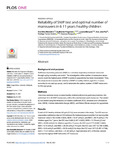Reliability of SNIP test and optimal number of maneuvers in 6-11 years healthy children

Use this link to cite
http://hdl.handle.net/2183/28060
Except where otherwise noted, this item's license is described as Creative Commons Attribution 4.0 International Licence (CC-BY 4.0)
Collections
- Investigación (FFISIO) [489]
Metadata
Show full item recordTitle
Reliability of SNIP test and optimal number of maneuvers in 6-11 years healthy childrenAuthor(s)
Date
2021-05-26Citation
Marcelino AA, Fregonezi G, Marques L, Lista-Paz A, Torres-Castro R, Resqueti V. Reliability of SNIP test and optimal number of maneuvers in 6-11 years healthy children. PLoS One. 2021 May 26;16(5):e0252150.
Abstract
[Abstract]
Background and purpose.
Sniff nasal inspiratory pressure (SNIP) is a voluntary inspiratory maneuver measured
through a plug occluding one nostril. The investigation of the number of maneuvers necessary to reach the highest peak of SNIP in pediatric populations has been inconsistent. Thus,
this study aimed to assess the reliability of SNIP in healthy children aged 6 to 11 years
according to sex and age group, and to determine the optimal number of SNIP maneuvers
for this age group.
Methods.
This cross-sectional study included healthy children with normal pulmonary function. We
performed 12 to 20 SNIP maneuvers, with a 30 s rest between each maneuver. The reliability was tested using the intraclass correlation coefficient (ICC), standard error of measurement (SEM), minimal detectable change (MDC), and Bland-Altman analysis for agreement.
Results.
A total of 121 healthy children (62 girls [51%]) were included in this study. The ICC and corresponding confidence interval (CI) between the highest measure and the first reproducible
maneuver were 0.752 (0.656–0.824), SEM = 10.37 cmH2O, and MDC = 28.74 cmH2O. For
children aged 6 to 7 years, the ICC was 0.669 (0.427–0.822), SEM = 10.76 cmH2O and
MDC = 29.82 cmH2O; for children aged 8 to 11 years, the ICC was 0.774 (0.662–0.852),
SEM = 9.74 cmH2O, and MDC = 26.05 cmH2O. For girls, the ICC was 0.817 (0.706–0.889),
SEM = 9.40 cmH2O and MDC = 26.05 cmH2O; for boys, the ICC was 0.671 (0.487–0.798),
SEM = 11.51 cmH2O, and MDC = 31.90 cmH2O. Approximately 80% of the total sample
reached the highest SNIP before the 10th maneuver.
Conclusions.
SNIP demonstrated moderate reliability between the maneuvers in children aged 6 to 11
years; older children and girls reached the SNIP peak faster. Finally, results indicated that
12 maneuvers were sufficient for healthy children aged 6 to 11 years to achieve the highest
SNIP peak.
Keywords
Reliability in engineering
Test reliability
Measurement errors
Intraclass correlation
Age groups
Test reliability
Measurement errors
Intraclass correlation
Age groups
Editor version
Rights
Creative Commons Attribution 4.0 International Licence (CC-BY 4.0)
ISSN
1932-6203






